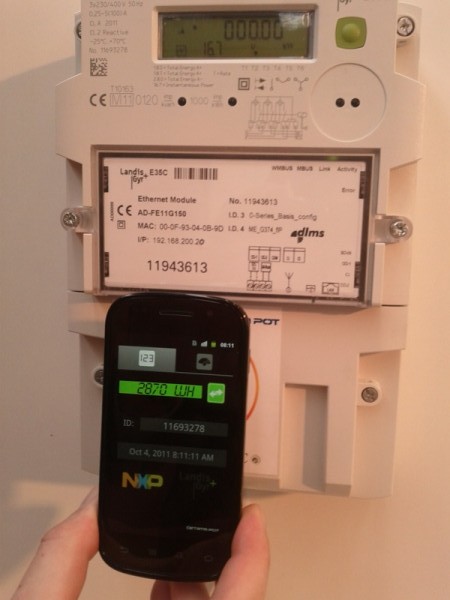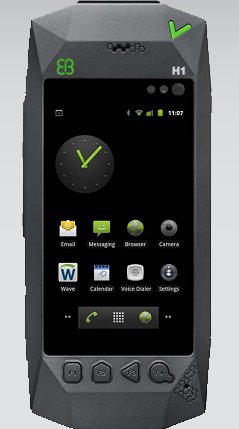NXP and Landis+Gyr are showcasing smart meters equipped with NFC technology at the Metering Europe 2011 event in Amsterdam this week. The companies are demonstrating how utility companies will be able to use NFC smart meters to: Save money by removing the need to include an LCD display in a smart meter. Meter readers will instead use an NFC-enabled phone to take a reading from the meter and then use their handset to collect and view current and historical energy consumption. Use an embedded secure element in the smart meter to increase customer privacy while at the same time providing the necessary level of access to installation and service technicians. Enable authorised maintenance technicians to download metering information to handsets or tablets as well as upload firmware updates to the meter via NFC. Use secure device pairing to deliver home area network (HAN) capabilities. Provide secure and convenient pre-payment of […]
Intel and Google to work on Android for Atom
Intel officially announced it will collaborate with Google to optimize the Android OS for Intel’s Atom processor platform in order to help Intel entering the smartphone market. In his keynote on the 13th of September – the first day of the Intel Developer Forum 2011 – Intel CEO Paul Otellini announced the partnership with Google to support Android on Atom processors and said the first Intel-based smartphones will be available in the first half of 2012. Paul Otellini demoed Intel’s Android smartphone reference platform running Android 2.3 (Gingerbread). The phone is 9.5mm thick, had an HDMI output, NFC support and features Intel’s 32nm Medfield processor which is said to include a newer generation GPU. Intel also showed off the new ISP (Image Signal Processor) capabilities in Medfield which is capable of capturing up to 20 fps at 1600 x 1200. However, the reference platform could only deliver 10 fps from […]
Nvidia Tegra 3 based Tablets Could be Ready for Xmas
Back in February at MWC2011, Nvidia announced its Tegra Roadmap including a demo of the Tegra 3 quad-core processor (Codenamed “Kal-El”) . Kal-El features a new Geforce GPU with 12 cores, giving 5 times greater performance than Tegra 2 and NVidia also provided benchmark results showing that Kal-El was faster than an Intel Core2 Duo T7200. Yesterday, NVidia CEO – Jen-Hsun Huang – announced that tablets based on Nvidia Tegra 3 could be available later this year, but that quad-core smartphones would only be available in 2012. Since Android 4.0 is likely to be released sometimes in October or November, we could see quad-core Android 4.0 tablet for Xmas although the schedule is very tight. He went on to say that there are only 2 active players in the high-end mobile processor market: Nvidia and Qualcomm (Qualcomm will ship its latest quad-core processor Snapdragon APQ8064 later in 2012). Nvidia CEO […]
Pogoplug Mobile: NAS for Mobile Devices
Cloud Engines is at IFA 2011 introducing the Pogoplug Mobile, a linux based NAS products specifically aimed at smartphones. It has a USB port to connect mass storage devices as well as a SD Card slot and an Ethernet port. There are 2 main use cases: Streaming: With a hard drive connected to the device (NTFS, FAT or other file systems are supported), you can stream music or video to your device from any place in a world as long as you have internet connectivity via 3G or Wifi. Media Upload: You take pictures or shoot videos with your smartphone and can upload them unto your hard drive via Pogoplug Mobile. To do those 2 tasks you’ll need to install an app on your iPhone or Android device. When you stream videos to your smartphone, the device will transcode the video to a format adapted to your smartphone, so that […]
NFC (Near Field Communication) Infographic
NFC rumors has designed a massive NFC Infographic to show (some of) the many different usages of NFC and the impacts NFC may have such as: NFC Services in hotels, taxis, ticket offices… NFC gadgets: routers, wireless speakers, headphones… NFC Marketing: tags, business cards, smart posters… 1/5 of smartphones will be NFC-enabled by 2014 NFC may have a positive environmental impact as it decreases the number of paper receipts. NFC Business Case: Exponential growth expected in the next few years NFC in tablets NFC and social network NFC would allow unbanked consumers in developing countries to use electronic payment more easily. etc.. See the infographic below. Click for a larger image. Jean-Luc Aufranc (CNXSoft)Jean-Luc started CNX Software in 2010 as a part-time endeavor, before quitting his job as a software engineering manager, and starting to write daily news, and reviews full time later in 2011. www.cnx-software.com
HTC Releases Unlock Bootloader Tool
HTC has finally released its “Unlock Bootloader” tool, that allows owner of HTC phones to develop software on their smartphone and/or to replace the current Android version by another version. Read HTC announcement below: HTC is committed to listening to users and delivering customer satisfaction. We have heard your voice and starting now, we will allow our bootloader to be unlocked for 2011 models going forward. We plan on releasing the updates that will allow you to unlock your bootloader in the coming months, please keep an eye on this website for more details on which devices will be adding this feature. We are extremely pleased to see the energy and enthusiasm from our fans and loyal customers, and we are excited to see what you are capable of. HTC eagerly anticipates your innovations. Currently it is only available for HTC Sensation (EU) with support planned for HTC EVO 3D […]
HTC Releases OpenSense SDK
HTC recently released OpenSense SDK, a framework encompassing all available HTC SDKs as well as features that will be offered in the future for HTC Sense user interface. Supported features include: Common Controls API: UI widgets and components that will provide developers with the ability to provide the Sense UI look and feel to their applications. Stereoscopic 3D (S3D) API: API documentation and sample code that illustrates how to programmatically enable the 3D display mode of the parallel barrier based screen for various types of applications. This API is provided as part of the phone add-on extension to the Android SDK. Tablet Pen API: API documentation and sample code for providing a framework for fully fledged drawing and painting applications as well as full access to the pen events at a low level. This API is provided as part of the tablet add-on extension to the Android SDK. API documentation […]
OMAP3 / OMAP4 Based Android Reference Designs for Smartphones and Tablets
Elektrobit (EB) announced their Specialized Device Platform (SDP), a reference design based on the Android operating system, targeted to Public Safety, Security and Defense, sectors with stringent compliance and regulatory requirements. The platform consists of form factor hardware that can be tailored to customer requirements. The current SDP has a TI OMAP 3 application processor, a high resolution touch-screen enabled display, Wi-Fi, Bluetooth, GPS, 2G and 3G modems – LTE for Band 14 being an option and runs Android 2.2 (Froyo). A version with TI OMAP 4 processor running Android 2.3 (Gingerbread) will be available in H1 2012. Linux Angstrom will also be provided for the platforms. Here are the details specifications of both reference platforms: OMAP3xxx ARM Cortex-A8 core up to 1 GHz ARM TrustZone compatible security engine NEON™ SIMD coprocessor POWERVR™ SGX graphics accelerator TMS320C64x+™ DSP up to 600 MHz OMAP4xxx Dual ARM Cortex-A9 cores up to 1.5 […]









